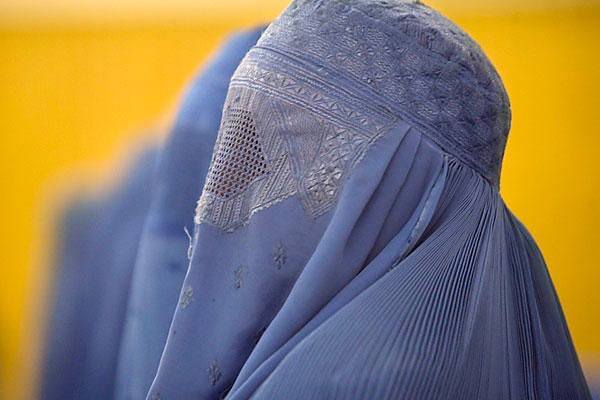This article is written by Bhanvi Juvekar, a law student at Unitedworld School of Law, Karnavati University, Gandhinagar.
Table of Contents
Who are Pardanashin Women?
Pardanashin women are often confused with women who wear burkha. But this is a misconception. Pardanashin women are women, who have almost zero contact with the outside world. They live in their homes, they go from their father’s house to the house that they are married into. However, they never interact with the outside world. They only have relations with the men and women in their house, that too from behind a ‘purdah’ or ‘veil’.
This is known as secluded living. A Pardanashin woman is one who observes complete reclusion because of the custom of the particular community to which she belongs. [1]
The practice of ‘parda’ was seen as a benchmark of status. Women belonging to the elite class practised this custom in the 19th century in India. The practice of ‘parda’ was practised by many women in the Hindu and Muslim community.
In Satish Chandra vs. Kali Dasi [2] it was said that a woman of rank who lives in seclusion, shut in the Zenana, having no communication except behind the parda or screen with any male persons save a few near relations. [3]
Due to these customs over time, women practising this custom became completely dependable on the males of the house.
Because of this they:
- Do not have the privilege to develop their own world view.
- Remain inexperienced due to lack of interaction with other human beings.
- Don’t have an education and are illiterate.
- Cannot interact with anybody outside their household so they do not know what is going on in the world outside their own house.
- Can be fooled easily as they cannot analyse a situation from many different angles: much like a small child who is dependent on his/her parents.
Because of the above-stated reasons, all affairs (legal or otherwise) of a pardanashin woman are managed by her husband or her other family members.
Pardanashin Women and the Indian Contract Law
Contract law in India is governed by the Indian Contract Act, 1872.
We enter into contracts every day- from buying groceries to buying a house. Although to enter into a contract and execute it safely, it very important to:
- Understand the terms of the contract.
- Comprehending the consequences of the concerned contract.
- To understand personal stake/role in the said contract.
A Pardanashin woman is incapable of understanding and interpreting the contract after fulfilling the above three conditions.
Why is it so?
In the case- Ashok Kumar And Anr. vs Gaon Sabha, Ratauli And Ors. [4] it was observed as under:
It is not merely by reason of pardah itself that the law throws its protection around a pardanashin lady but by reason of hoe disabilities to which the life of a section of people living in seclusion gives rise to the disabilities and with which a pardanashin lady suffers. [5]
Because of her disabilities and inability to understand the terms of a contract a pardanashin woman can be easily influenced by anybody. She can be persuaded to sign a contract that is not in her favour and harms her. Anybody can use her disabilities against her for their own benefit.
The legislature understood this problem and detected a need to protect pardanashin women. They did this by protecting them under Contract law. [6]
She is protected by the provision for undue influence ( section 16) [7] that states:
- A contract is said to be induced by “under influence” where the relations subsisting between the parties are such that one of the parties is in a position to dominate the will of the other and uses that position to obtain an unfair advantage over the other.
- In particular and without prejudice to the generally of the foregoing principle, a person is deemed to be in a position to dominate the will of another:
- Where he holds a real or apparent authority over the other, or where he stands in a fiduciary relation to the other; or
- Where he makes a contract with a person whose mental capacity is temporarily or permanently affected by reason of age, illness, or mental or bodily distress.
A pardanashin woman is susceptible to undue influence and therefore, the law throws around her a “Special cloak of protection” i.e. Where such a woman signs a sale, mortgage, gift or release, the person obtaining her signatures has to prove that the transaction was not only explained to her but also that she had understood the transaction and that there was no undue influence. [8]
The general practice of assuming that the person signing the contract has understood it is not followed in the case of a pardanashin woman. [9] The case of a pardanashin woman is considered exceptional and the other party has to prove that the pardanashin woman was not influenced and she fully understood the situation she was getting herself into just like any other reasonable person would.
Apart from other considerations applicable, if the document executed is not in the mother tongue of the executant, the law requires further that she understood the document and not merely heard its contents. [10]

But, pardanashin term has been given a definite legal meaning. The only conditions when a woman can claim to be pardanashin are when:
- She is illiterate;
- She is ignorant as she has never set a foot in the outside world.
Considering the above two conditions, it is safe to conclude that any woman who is illiterate, ignorant, lacks experience and is incapable of understanding the terms of a contract can claim the protection given to pardanashin women under undue influence.
This has been stated in Laxmi Narain & Another v. Hubraja: [11]
Rules regarding transactions by a Pardanashin lady are equally applicable to an illiterate and ignorant woman, though she…may not be a Pardanashin. It is not by reason of the Pardah itself that the law throws its protection around a Pardanashin lady but by reason of those disabilities which a life of seclusion lived… [12]
It has also been stated in Ashok Kumar And Anr. vs Gaon Sabha, Ratauli And Ors: [13]
Where ignorance and illiteracy are proved to expose the woman concerned to the danger and risk of an unfair deal, it would be a perversion of the rule to deny in such case the protection, despite the helplessness of her state, merely on the ground that she is not a pardanashin lady. [14]
But this principle also applies to men as in Daya Shanker v. Bachi, [15] who by their physical or mental capacity are prone to easy influence and after inducement tends to enter into contract or transactions relating to purchasing and sale of the property. [16] The principle on which the protection by law is accorded to a pardanashin women is based on equity and good conscience. [17]
Since the other party has to prove that there was no undue influence, the burden of proof falls upon the other party.
In order to prove the other party has to establish that:
- The terms of the contract were fully explained to her.
- She fully understood the terms of the contract explained- just like any other reasonable person would.
- She understood the pros and cons arising out of the contract and her role in it.
- Her consent was free.
Both of these protections can be claimed only when somebody is completely pardanashin. Partial followers of this practice are not offered such protection. [18]
Case Laws
Case laws are being referred here in order to better understand judicial reviews in case of a contract with pardanashin women:
Ismail Mussajee v. Hajiz Boo, [19] it was held that a woman who goes to the court and gives evidence, settles rents with her tenants and collects rents and communicates in a matter of business with men other than the member of the family is not a pardanashin woman.
This case law shows that partial practice of the pardanashin custom is not given the advantage of claiming protection under the law.
Kalibaksh Singh v. Ram Gopal Singh [20] it was held by Privy Council that the proof must go so far as to show affirmatively and conclusively that the deed was not only executed by, but also explained to, and was really understood by the grantor. In such cases, it must also be established that the deed was not signed under duress and also arose from the free and independent will of the grantor.
This case specifies what the other party has to prove in order to satisfy their duty of providing proof against the pardanashin woman.
Chidambaram Pillai v. Muthammas, [21] it was held that a pardanashin lady may not be illiterate. If she is fractional, excluded from social intercourse and communication outside void, she will fall in this category.
This case goes further to define the category of pardanashin women. It gives clarification by stating the necessary conditions for a woman to fall under the ambit of ‘pardanashin women’.
Conclusion
From the analysis of the situation of pardanashin women and studying various cases related to it, we can safely interpret that pardanashin women are prone to undue influence. They can be manipulated easily and can be taken advantage of.
In order to protect the interests of these women, the law provides them protection through the section of undue influence and places the burden of proof on the other party.
However, to ensure that no woman misuses these protections, the judiciary has in many cases defined the boundaries of the category-‘ pardanashin women’. They widened the scope of this category for all who are illiterate and unable to make their own decisions and also narrowed it so as to bar women who practice this custom only partially.
These methods protect the interest of pardanashin women and people who are illiterate and can be manipulated easily both.
References
[1] https://shodhganga.inflibnet.ac.in/bitstream/10603/43089/11/11_chapter%202.pdf.
[2] Satish Chandra vs. Kali Dasi AIR 1922 Cal 203.
[3] https://www.clcbd.org/lawdictionary/201.html.
[4] AIR 1981 All 222.
[5] Ashok Kumar And Anr. vs Gaon Sabha, Ratauli And Ors AIR 1981 All 222.
[6] Indian Contract Act, 1872.
[7] Ibid.
[8]https://www.coursehero.com/file/p72e3lpo/Pardanashin-Women-A-pardanashin-woman-is-susceptible-to-undue-influence-and/ accessed on 15 April 2020.
[9] Mariam Bibi v. Sakina, (1892] 14 All 8.
[10] Hussain Bai v. Zohra Bai, AIR [1960] (MP) 60.
[11] https://www.casemine.com/judgement/in/5767b11fe691cb22da6d4037 accessed on 15 April 2020.
[12] Laxmi Narain & Another v. Hubraja on https://www.casemine.com/judgement/in/5767b11fe691cb22da6d4037 accessed on 15 April 2020.
[13] AIR 1981 All 222.
[14] Ashok Kumar And Anr. vs Gaon Sabha, Ratauli And Ors AIR 1981 All 222.
[15] AIR 1982 All 376.
[16] https://blog.ipleaders.in/undue-influence-contract/ accessed on 15 April 2020.
[17] Tara Kumari v Chandra Mauleshwar Prasad Singh AIR 1931 PC 303. See also, https://blog.ipleaders.in/undue-influence-contract/ accessed on 15 April 2020.
[18] https://blog.ipleaders.in/analysis-section-10-indian-contract-act-1872/.
[19] (1906) 33 Cal. 773.
[20] (1913) 41 IA 223.
[21] (1993) ILW 466.
LawSikho has created a telegram group for exchanging legal knowledge, referrals and various opportunities. You can click on this link and join:
https://t.me/joinchat/J_0YrBa4IBSHdpuTfQO_sA
Follow us on Instagram and subscribe to our YouTube channel for more amazing legal content.











